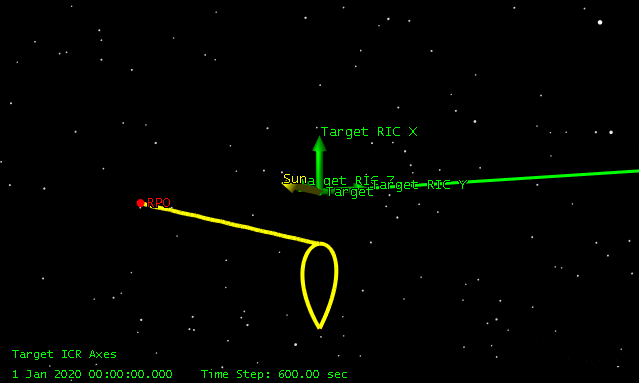Tear Drop RPO Sequence
The Tear Drop RPO sequence performs a teardrop relative orbit. First, the sequence moves the satellite from the current position to the starting point of the teardrop using a set of forced-motion waypoints. By default, it moves the chase satellite in a near-straight line along the path connecting the current relative position to the starting position of the teardrop.
If you prefer a simple hop instead of a series of waypoints, then set the Way_MaxDegrees parameter to a large value (>180 deg).
The starting point of the teardrop is the turnaround point of the teardrop on the RBar. You must specify the radial distance from the target to perform the radial maneuvers to maintain the teardrop and the turnaround point of the teardrop.
The teardrop can be on top of the target, below the target, or even encompass the target. The teardrop relative orbit is for circular orbits only. While it is possible to perform a teardrop relative to an eccentric orbit, the sequence does not provide this capability.
The following picture shows a teardrop that turns around on the RBar at -300 meters and maneuvers on the RBar to -800 meters. This example shows the sequence performing five maneuvers over one revolution for a total Delta-V of 84 cm/sec.

Sequence parameters
| Option | Description |
|---|---|
| TearDrop_Duration | Enter the duration to persist in the teardrop relative orbit. |
| TearDrop_TurnAround | Enter the radial distance from the target for the teardrop turnaround. |
| TearDrop_Maneuver | Enter the radial distance from the target for the teardrop maneuver. |
| Transfer_Duration | Enter the transfer time from current position to the start of the teardrop. |
| Way_MaxDegrees | Enter, in angle units, the maximum spacecraft degrees between hops for the forced motion part that connects the current position to the start of the teardrop. |
| Engine_Name | Enter, as a string, the name of the finite maneuver engine model. |
| Maneuver_Type | Select the type of maneuver, "Impulsive" or "Finite," from the drop-down list. |
| WhoAmI | Enter, as a string, the name of the current satellite. |
| ThisSequence | Enter, as a string, the name of this sequence. This is nominally TearDrop, but if you insert the sequence multiple times in the MCS, Astrogator adds a monotonically increasing number to the end of the name (TearDrop1, TearDrop2, etc.) |